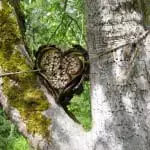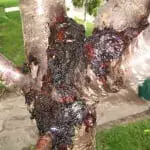Learn how to choose the best companion plants for your fruit trees, build simple and effective guilds, and avoid common Read more
Fall Priority: Remove Rotting Fruit Mummies from your Fruit Tree

One of my favorite historic orchards in Toronto is at Spadina House, a grand estate dating back to the 19th century. This public orchard is never sprayed with fungicides or pesticides, so sometimes the trees get sick. This year, a number of the heirloom apple trees had lots of shrivelled up, dead fruitlets on the bare branches over the winter. These are called "fruit mummies" and they can be responsible for spreading disease.
So, in episode 104 of the Orchard People fruit tree care podcast, I interviewed Kerik Cox, Ph.D., a plant pathologist, mycologist, and bacteriologist, from the Cox Program at Cornell University College of Agricultural and Life Sciences. He explained what fruit mummies are, why they form, and how to know if they are sign of disease. We also explored why removing fruit tree mummies can be an important step when you are going through the process of preparing your fruit trees for winter.
So let's dig in!
What Causes Fruit Mummies?
Fruit trees naturally produce more fruitlets than they can support, so they shed substandard ones early in the season—a process often called "thinning"or “June drop.” This drop allows the tree to conserve energy, ensuring the remaining fruit can grow to full size.
But not all of the fruit left on the tree’s branches will be good. So, if a tree doesn’t have enough nutrition to support all of its growing fruit, it will channel its energy into the best of the bunch and the remaining ones may stay small. Slowly, those neglected fruitlets will die. Some will fall to the ground. Others will remain on the tree.
While “thinning” is a natural process that happens to healthy trees, fruit mummies can also be a sign of disease. Examples on apple trees include bitter rot (Colletotrichum), a fungal disease that can damage the apples, or the deadly bacterial disease fire blight (Erwinia amylovora), which can take out an entire orchard in a matter of weeks.
Fruit mummies can also form as a result of environmental damage. For instance, a late frost can wreak havoc with fruit trees, killing the smaller and more vulnerable fruitlets while the stronger and larger ones may survive. The problem is that the dead fruit mummies that remain on the tree can be an attractive destination for disease pathogens. And that is not a good thing.
Can Fruit Mummies Spread Disease?
According to Kerik, fruit mummies on stone fruit trees are actually more dangerous than fruit mummies on apple trees. Stone fruit mummies often get fuzzy due to a disease called brown rot (Monilinia fructicola). That fuzz is what Kerik calls “Fungal babies,” which are baby spores that will spread around your garden or orchard and affect other fruit trees.
But apple mummies don’t usually spread disease in the same way. Kerik explains:
“If you have a stone fruit and it looks fuzzy, maybe worry. If it's an apple tree, I would not worry so much. While the apple mummies that result from diseases may not always be vectors for disease, they will probably result in a poor-quality harvest with much of the fruit being rotten inside.
But whole many apple mummies aren't a threat in terms of disease, there are some apple mummies that can spread disease and it's important to know how to recognize them. So, let's explore a number of the apple diseases that result in apple mummies next.

Fire Blight Apple Mummies
One of the deadliest infections that apple trees can get is fire blight (Erwinia amylovora). An apple mummy on a tree with fire blight looks smoother and less shriveled than typical mummies.
“If it feels sticky to the touch, that’s just loaded with fire blight cells,” Kerik explains. “Or, if you get to the middle of the summer and droplets are forming on your fruit, that means fire blight has ridden the water slide straight to the fruit and is bursting out. It will get into the vascular tissue of the tree and move to the active growing tissues.”
If you find this type of apple mummy remove it, bag it up, and pop it into the garbage to prevent the spread of this devastating disease. Then, inspect the rest of your tree carefully. Look for new growth that has turned brown or black and curled up into a “shepherd’s crook”—a symptom of fire blight. This bacterial disease can spread quickly in warm, wet weather.
Large apple trees on full-sized rootstocks have extensive root systems, and they might be able to tolerate fire blight. In that case, carefully cut off and destroy the affected branches or bag them up and send them to municipal waste.
But most apple trees today are grafted onto dwarfing or semi-dwarfing apple rootstocks, and in those cases fire blight can be deadly, killing small trees in a matter of weeks. Prune out diseased tissue here too....but if you are planting new apple trees, it’s wise to invest in cultivars from your local fruit tree nursery that are resistant to fire blight to avoid this devastating disease that affects both apples and pears.

Bitter Rot Apple Mummies
Apple mummies resulting from bitter rot, caused by the fungus Colletotrichum, have distinct features. A tell-tale sign is dark, ringed spots on the skin. If you cut the fruitlet open, the flesh under the spots will be black or brown and rotten.
Eventually, these fruitlets become more wrinkled and leathery and they might have tiny salmon colored droplets on them. In this situation, affected fruitlets can easily spread this disease to other apple trees, infecting healthy fruit, reducing yield, and causing significant crop loss. In severe cases, the disease can weaken the tree, making it more susceptible to other infections and pests.
So here again, you want to remove affected fruitlets and take them off the site.
Bitter rot, like fire blight, thrives in warm, humid conditions.

How to Prevent Fruit Mummies and Fruit Tree Fungal Diseases
Fruit mummies aren’t good for fruit trees. Here are five ways to prevent apple mummies:
1. Remove Fruit Mummies from Your Tree
If you have one or two trees, check them weekly and remove any mummy fruits you see. Often, it’s easy to pluck off the mummies, but according to Kerik, some cultivars, like Fuji and Cortland apples, hold on tight! In those cases, you may need to cut off the mummies with heavy-duty scissors or pruners.
2. Prune Your Fruit Trees Correctly
Proper apple tree pruning creates an open canopy that allows air flow and sunlight in, keeping leaves dry. Most disease pathogens prefer dark, damp conditions. As Kerik says, “Air is the best fungicide and bactericide.” Don’t just trim around the edges; remove entire branches strategically to reduce crowding. Learn more in Orchard People’s online course Certificate in Fruit Tree Care.
3. Irrigate Your Trees Correctly
Sprinklers waste water and can damage fruit trees by wetting the entire canopy instead of focusing on the roots. Keeping the canopy dry helps protect your fruit tree from diseases that cause apple mummies. The best ways to water fruit trees will involve soaker hoses, drip lines or other tools that keep the water focused on your tree's root system.
Fruit Trees
That Thrive

4. Practice Good Fruit Tree Hygiene
Whether you’re growing apple, pear, or stone fruit trees, sanitation is key. Kerik advises, “If it’s not making you fruit and it looks dead, remove it—whether it’s a branch, a piece of wood, a canker, a shoot, or a mummy. All of that is a reservoir for bacteria and fungi.” Remove leaf litter around the tree to prevent pests and pathogens from overwintering and returning in greater numbers in spring.

5. Use Microbe-Rich Mulches
For small-scale growers, homemade compost, composted manure, or arborist wood chips can serve as microbe-rich fruit tree mulch. For larger orchards, Kerik suggests using urea pellets, a nitrogen-rich fertilizer. “In commercial orchards, we put feed-grade urea prills on the ground. The urea enhances the microbial communities in the soil, breaking down leaf litter and apple mummies like a compost pile.”
Should you Put Fruit Mummies in your Compost?
So, if active compost can kill fruit mummies, should you put infected fruit mummies in your compost? Well, that’s something I personally would avoid. In our community orchard, our compost pile is relatively small and never gets very hot. My concern would be that the pathogen would survive and come back to haunt us (and our fruit trees) in the years to come.
Instead, we rake up the leaf litter and fallen fruit (including fruit mummies) from around our trees. We bag it up and send it off to our city’s leaf litter collection program. They then dump these bags into huge, steaming hot compost piles that will kill any pathogen unlucky enough to find itself hiding inside.

How Do You Protect Your Tree From Disease?
In the end, think about fruit tree mummies as a way for your tree to communicate with you. If your tree gets lots of fruit mummies, it’s time to start thinking about how you care for it. Are you pruning it properly each year? Are you giving it the nutrients it needs? You can learn how to do that and much more in my online course Certificate in Fruit Tree Care and in my other online courses.
Happy Growing!

Susan Poizner
Susan Poizner is an urban orchardist in Toronto, Canada and the award-winning author of three fruit tree care books. Susan trains new growers worldwide through her award-winning fruit tree care training program at Orchardpeople.com and is a former instructor of Fruit Production at Niagara College in Ontario. Susan is also the host of Orchard People, a monthly radio show and podcast, and Susan is an ISA Certified Arborist.



